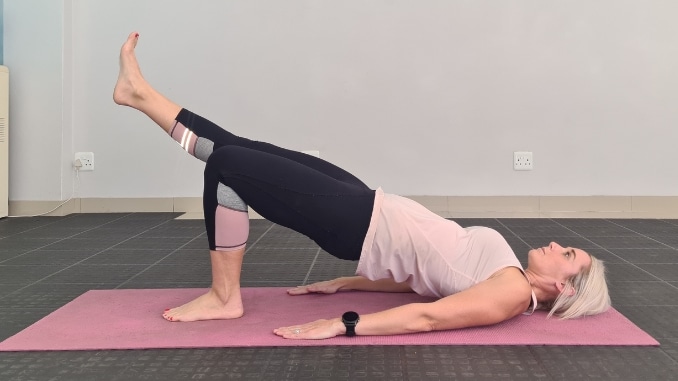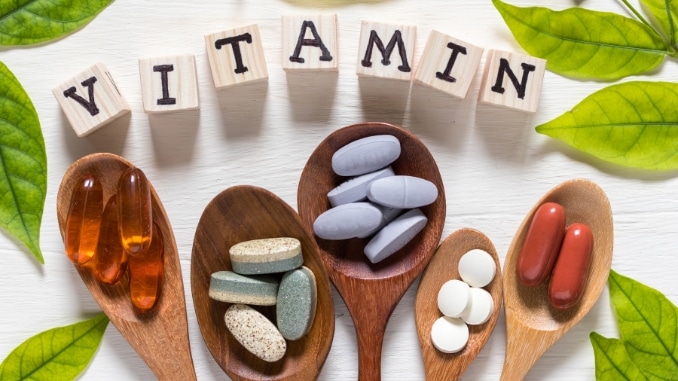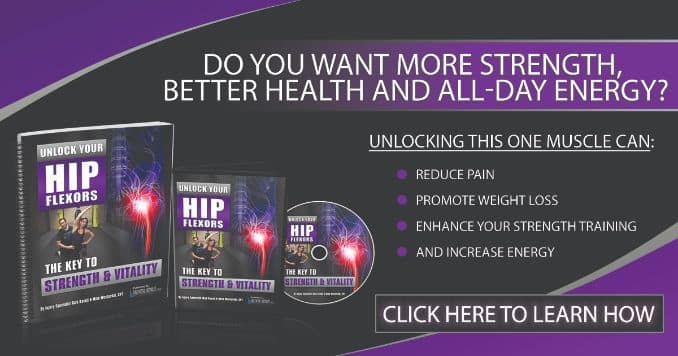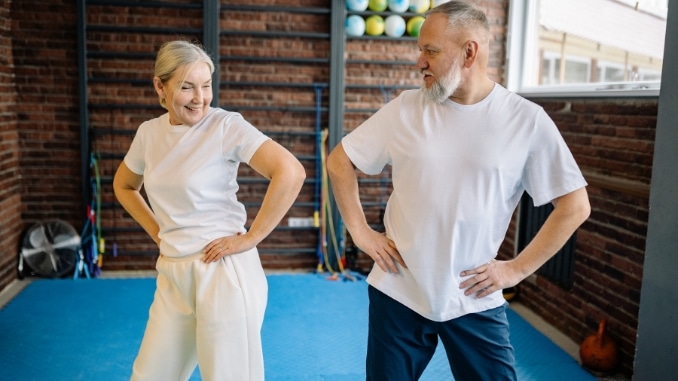
Hip mobility problems are increasingly common, affecting people of all ages. Sedentary lifestyles, obesity, and aging contribute to this issue. Proactive steps are crucial in preventing and managing hip discomfort. Regular hip exercises, like floor exercises for hips, can enhance joint stability and reduce pain. Maintaining a healthy weight through proper nutrition eases the burden on the hips. Avoiding excessive sitting and ensuring good posture are essential lifestyle changes. Prioritizing hip health can significantly enhance the quality of life, independence, and overall well-being, underlining the importance of preventive measures for individuals of all ages.
What Are The Common Causes of Hip Problems?
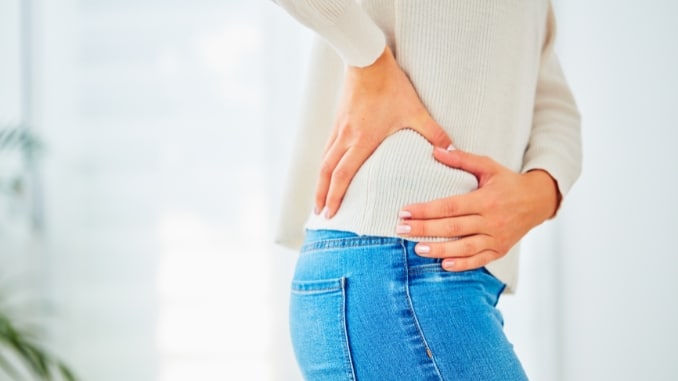
Hip problems can significantly impact daily life, from walking and sitting to overall mobility. While these issues can result from a variety of factors, several common habits are known to contribute to hip discomfort and pain. In this context, it’s essential to understand how the common causes of hip pain collectively affect hip health, emphasizing the importance of preventive measures and lifestyle adjustments to maintain strong and pain-free hips.
1. Sedentary Lifestyle
Continued sedentary behavior or insufficient physical activity may result in weakened hip muscles, which are essential for stabilizing the hip joint. Weak muscles may not adequately support the joint, leading to hip pain and discomfort.
2. Poor Posture
Maintaining improper posture, such as slouching or sitting with crossed legs, can increase the load on the hip joints and the adjacent soft tissues. Over time, this can result in hip pain and even musculoskeletal imbalances.
3. Overexertion
Participating in high-impact activities like running or sports without proper warm-up, stretching, or technique can strain the hip flexors, joints, tendons, and ligaments. Overuse or repetitive stress can lead to hip injuries, such as strains or bursitis.
4. Obesity
Additional body weight places added stress on the hip joints. The hips bear the brunt of this weight, and over time, it can lead to accelerated wear and tear on the joint, escalating the risk of hip pain and conditions like osteoarthritis.
5. Inadequate Nutrition
Proper nutrition is essential for maintaining healthy bones and cartilage. A diet deficient in essential nutrients like calcium and vitamin D can weaken these structures, potentially accelerating hip problems and making them more susceptible to injury or disease.
6. Ignoring Pain
Neglecting early signs of hip discomfort, minor injuries, or mild pain can worsen conditions. Failing to address these issues promptly may require more extensive treatment or even surgery in the long run, highlighting the importance of early intervention for hip health.
Five Floor Exercises For Hips
1. Glute Kickbacks
Lie on your stomach with your feet shoulder-width apart, maintaining good alignment with your head, shoulders, hips, and legs. Rest your forehead on your bent arms. Engage your core and inhale deeply as you lift your right leg, keeping your leg straight. Hold this position for several deep belly breaths in through your nose and out through your mouth. Lower your leg back down to the starting position and repeat the movement on the opposite leg.
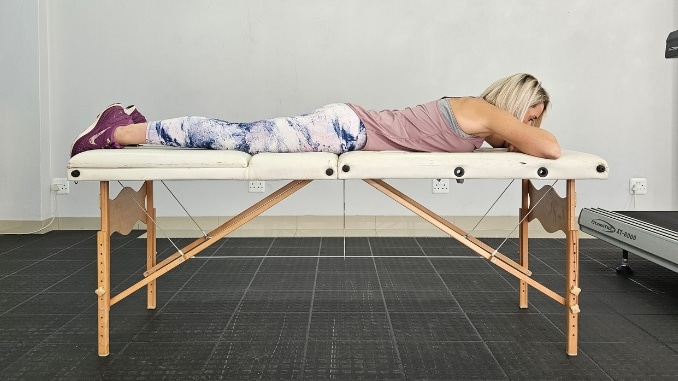 |
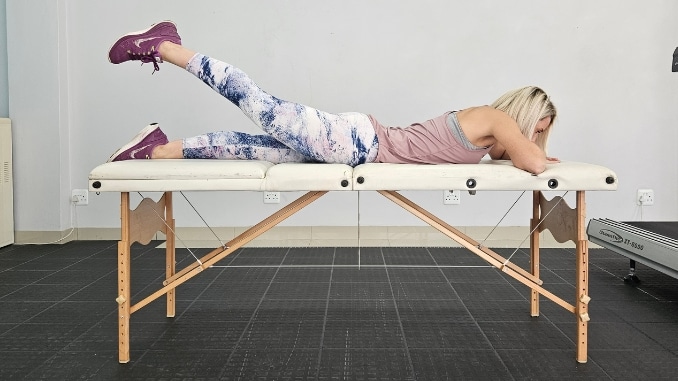 |
Straight-Leg Raise to the Back
2. Straight Leg Glute Bridge
In this floor exercise for hips, lie on your back with your legs extended, maintaining good alignment with your head, shoulders, hips, and legs. Place your arms on your sides. Engage your core, push through your heels to lift your hips, and squeeze your glutes at the end position. Hold this position for several deep belly breaths in through your nose and out through your mouth. Lower your hips to return to the starting position. Repeat the movements for 12 repetitions. Start with 1 set of 5 repetitions.
 |
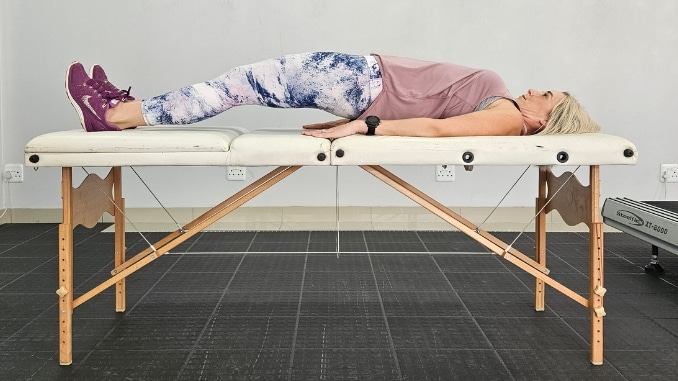 |
Straight-Leg Glute Bridge
3. Bridge
Lie on your back on the floor with your knees bent and feet flat on the floor, maintaining good alignment with your head, shoulders, and hips. Place your arms on your sides. Engage your core and push from your heels to lift your hips, squeezing your glutes at the end position. Hold this position for several deep belly breaths in through your nose and out through your mouth. Slowly lower your hips to return to the starting position. Repeat the movements for 12 repetitions. Start with 1 set of 5 repetitions.
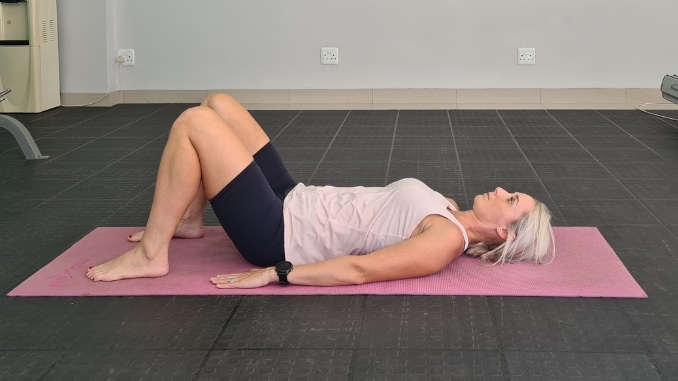 |
 |
Bridge
4. Bridging with Leg Straight
In this floor exercise for hips, lie on your back on the floor with your knees bent and your feet flat on the floor, maintaining good alignment with your head, shoulders, and hips. Place your arms at your sides, relaxing your upper body. Engage your core. Push from your heels to lift your hips, straightening your right leg with your toes pointing upward. Hold the position for a couple of seconds, then return to the starting position. Alternately repeat the movement on the other leg. Start with 1 set of 5 repetitions on each side.
Bridging with Straight Leg
5. Bridge with Band
Lie on your back on the floor with your knees bent and feet flat on the floor, maintaining good alignment with your head, shoulders, and hips. Wrap the mini band around both legs, just above the knees, to strengthen your thigh muscles. Place your arms at your sides. Engage your core and push from your heels to lift your hips, squeezing your glutes at the end position. Hold this position for several deep belly breaths in through your nose and out through your mouth. Slowly lower your hips to return to the starting position. Repeat the movement for 12 repetitions. Start with 1 set of 5 repetitions.
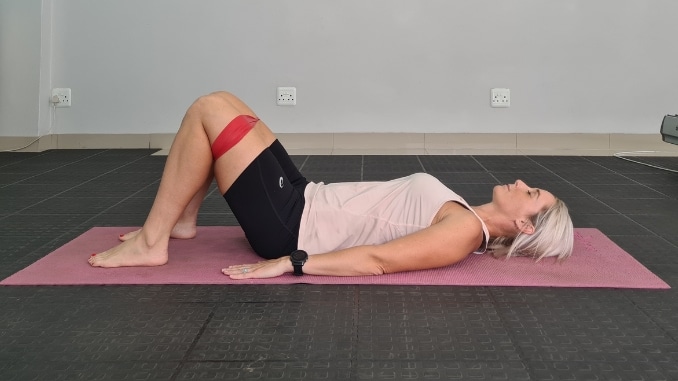 |
 |
Bridge with Band
Additional Hip Exercises
1. Single Leg Deadlifts
For this floor exercise for hips, you can either perform the movement as bodyweight or you can utilize the wall, the back of the chair, or anything stable for balance if needed.
To begin this exercise, stand with your feet hip-width apart, maintaining good alignment with your head, shoulders, hips, and legs. Contract your abdominal muscles and transfer all of your weight to your left foot. Slightly bend your supporting knee and hinge your hips, bending forward until your upper body is parallel to the floor while extending your right leg back. Raise back up to return to the starting position and repeat the movement on the opposite side. Start with 1 set of 10 repetitions on each side.
2. Side-Lying Leg Raises
Lie on your left side with your head resting on your hand, keeping your shoulders, hips, and legs in alignment. Bend your left leg. Tighten your core and lift your right leg to a 30 to 45-degree angle, keeping your toes facing forward to target the glutes. Lower your leg back down to the starting position and repeat the movement.
This floor exercise strengthens the muscles on the side of your hips and enhances hip stability.
3. Clamshell Exercise
Lie on your side with your knees bent and your head resting on your outstretched arm. Engage your core and hinge from your ankles to lift your top knee. Lower your knee back down to the starting position and repeat the movement.
To make the exercise more challenging, loop the resistance band around your legs, just above your knees. Start with 1 set of 10 repetitions on each side.
4. Pigeon Pose
Move into a straight-arm plank position, maintaining good alignment with your head, shoulders, hips, and legs. Lift your right knee towards your shoulder, cross your foot under your opposite hip, and lower your knee to the side. Lower your upper body onto your bent leg and rest your forehead on your bent arms. Hold this position for several deep belly breaths, in through your nose and out through your mouth. Return to the starting position and repeat the movement on the opposite leg.
Start off with one set of 1 repetition on each side, holding for 10 seconds.
5. Seated March
Begin in an upright sitting position on a sturdy chair with your knees bent and feet flat on the floor. Place your hands on the sides of the chair for support and balance. Engage your core. Keeping your knee bent, drive your left knee up towards your chest. Lower your leg back down to the starting position and repeat the movement on the right leg. Start with 1 set of 10-12 repetitions on each leg.
The Seated March is a convenient floor exercise for hips that promotes hip mobility and strength.
6. All Four Hip Circles
Begin on all fours, with your hands placed directly under your shoulders and your knees under your hips. Engage your core. Lift one knee to the side while keeping it bent and start drawing circles in a counterclockwise direction and switching to a clockwise direction. The movement should originate from the hip joint. Lower your leg to return to the starting position and repeat the movement on the opposite leg. Start with 1 set of 10 circles on each leg.
7. Standing Hip Flexor Stretch
Begin in an upright standing position, maintaining proper alignment with your head, shoulders, hips, and legs. Place your hands on your hips. Take a big step forward with your right foot, keeping your toes pointing straight ahead. Bend your front knee and straighten your back leg. Tighten up your abdominal area, shift your hips forward, and raise your left heel. Return to the starting position and repeat the movement. Start with 1 set of 10 repetitions on each side.
Depending on your comfort level, perform this routine as a Floor Hip Flexors Stretch, as this can regularly help improve flexibility in the hip flexors and alleviate tension in the lower body.
Five Essential Vitamins for Hip Health
Complementing exercise with proper nutrition, specifically by ensuring an adequate supply of essential vitamins, is crucial for maintaining hip health. Without proper nutrient supply, exercise alone may not maximize bone density, joint integrity, and overall hip function, emphasizing the vital link between nutrition and physical activity in hip health maintenance. Here are five essential vitamins that play a key role in promoting hip health:
1. Vitamin D
Having adequate Vitamin D is essential for ensuring the strength and health of your hips because it aids in absorbing calcium, which is essential for bone health. Vitamin D can be acquired from natural sources such as fatty fish (e.g., salmon and mackerel) and fortified foods like dairy products and cereals.
2. Vitamin K
Vitamin K is vital in bone metabolism and can contribute to hip health. Collard greens, spinach, kale, broccoli, and Brussels sprouts are abundant in vitamin K.
3. Vitamin C
This specific vitamin holds a crucial function in synthesizing collagen, a protein that offers structural support to bones and joints, such as the hips. Incorporate vitamin C-rich foods like citrus fruits (oranges, grapefruits), strawberries, bell peppers, and kiwi into your diet to support hip health.
4. Calcium
Calcium is a primary bone tissue component and critical for maintaining hip strength. Dairy products like milk, yogurt, and cheese are excellent sources of calcium, as are fortified non-dairy alternatives like almond or soy milk.
5. Magnesium
Magnesium contributes to the metabolism of calcium and supports bone wellness. Nuts, seeds, and whole grains like almonds, pumpkin seeds, and whole wheat are rich in magnesium, contributing to hip health when consumed as part of a balanced diet.
Conclusion
In conclusion, maintaining healthy hips is vital for overall well-being and quality of life. Hip pain and problems, often caused by factors like a sedentary lifestyle, poor posture, overexertion, obesity, and inadequate nutrition, can significantly impact daily activities. However, taking proactive steps to prevent and manage hip discomforts, such as regular exercises like floor exercises for hips and proper nutrition, is essential.
The five-floor exercises outlined above, combined with a diet rich in essential vitamins like D, K, C, calcium, and magnesium, offer a holistic approach to supporting hip health. By acknowledging the significance of engaging in physical exercises and nutrition, individuals of all ages can enhance their hip strength, joint stability, and independence for a healthier, pain-free future.
Release your tight hips, increase your flexibility, improve your strength, and safeguard yourself from future injuries, safely and naturally. Check out Advanced Unlock Your Hip Flexors now!


